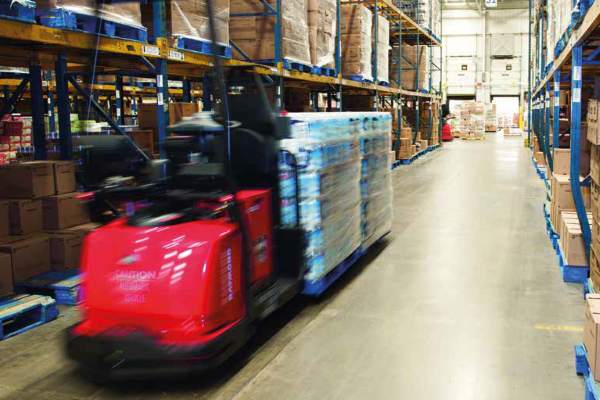Published on the 31/01/2018 | Written by Steve Smith

When you hear talk about robotics in the distribution centre, you may envision some of the innovations Amazon is using to streamline operations…
Maybe you picture self-guided forklifts equipped with sensors and automatic controls stacking inventory in racks soaring high above the distribution to fulfilment without humans getting in the way and slowing things down. But you might be surprised to learn that robots are transforming more than just the physical tasks of fulfilment centres. The last several years have seen drastic shifts in every link of the supply chain. Today, lines of business have to demonstrate the ability to scale in order to meet the ever-increasing speeds of commerce. While physical robots may help warehouses and distribution centres move products from point A to point B more quickly, there’s only so much such operations can be sped up without a correlating efficiency in back-office processes. “These ‘robots’ can perform the same tasks currently performed by humans without ever slowing or making errors.” But document-heavy, transactional process are benefitting from “robots,” too. Robotic process automation (RPA) uses computer software to push data from one application to the next through automated communication systems. RPA is the latest iteration in a lightning- fast evolution of automated document processing technology that started with EDI. More than likely, your fulfilment centre already uses an electronic data interchange (EDI). These systems grab information from the sales order, process it through the warehouse and feed it to an invoicing system in a standard electronic format according to a pre-configured mapping system. EDIs are a critical first step in the digitization of the supply chain and fulfilment operations, but they still require a significant amount of manual processing in order to handle exceptions such as incorrect pricing or customer information. EDI systems, then, can’t really be classified as “automated” because at their core, they’re still manual systems. They evolve through new technologies like dynamic data capturing (DDC), graphical user interfaces and optical character recognition (OCR), which come together to create fully automated capabilities for document-heavy workloads such as accounts payable and sales order processing. Document processing automation is really all about improving communication and collaboration between key stakeholders in a customer transaction. As business processes become increasingly digitized, the lines between departmental functions like customer service, fulfilment and accounting are blurring. Customers now expect every interaction to move at “Amazon speed,” and businesses are scrambling to increase transparency with innovations like customer portals and online ordering capabilities. These technologies have led to truly automated processes that virtually eliminate manual touchpoints. A report on sales order solutions for the supply chain from Gartner and Esker shows a range of positive results from document processing automation, including: While it can be difficult to pinpoint exactly where traditional document process automation ends and RPA begins, most experts agree that RPA’s major differentiator is the ability to essentially automate the automated processes. In other words, those tasks that were performed at the edges of automation, such as review and approval, quality assurance and inspection, were still entrusted only to human workers for a variety of reasons like risk control or the historically high cost of changing legacy workflows. But the speed of business and the sheer volume of transactions today necessitate that competitive organisations evolve to RPA. Think of it this way: Fifteen years ago, if you needed to buy groceries, you went to the store, physically picked out the products you wanted to buy and gave your credit card to a cashier to manually swipe. Then cashiers began to be eliminated from the equation via self-checkout kiosks, where you ring up your own groceries and directly pay a machine. Today, an increasing number of consumers don’t make the trip to the grocery store at all. Instead, they pick out the products they need, pay online and have their groceries delivered directly to their door. The core function – purchasing groceries – was automated long ago. The latest evolution automated those steps at the edges of the purchase — picking out the products, ringing them up and getting them home. A good rule of thumb when identifying areas where RPA can add value to distribution centre operations is to look at any process that is performed over and over, such as funnelling fulfilled orders to accounting for invoicing, or where the process is one of redundancy, like reviewing or auditing processes. After all, if you have automated “robots” performing document processing tasks with near-perfect results, how much value can a human auditor add? The bottom line is that these “robots” can perform the same tasks currently performed by humans without ever slowing or making errors. According to a report from Aberdeen, there are significant gaps between distributors considered “Leaders” (the top 30 percent of performers) and those classified as “Followers” (the remaining 70 percent of organisations), such as: If distribution is seeing an invasion of the robots, then it’s a welcome sight. Fulfilment centres no longer operate in a silo, and warehouse managers must expand their purview to include touchpoints at the edges of their link in the supply chain. Digital technology has changed the distribution landscape at a fundamental level, and many managers are struggling to find ways to further optimize their operations. For those searching for ways to streamline their warehouses and gain the competitive edge, they’ll find their solution in robotics. Steve Smith is the U.S. chief operating officer at Esker. He is responsible for all operations in North, South and Central America.




























